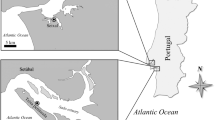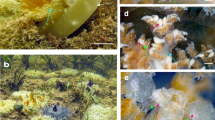Abstract
Jellyfish have an increasing impact on marine ecology. Cnidocysts bearing stinging cells afford, amongst others, prey capture and defence. Several different types of stinging capsules are found in one species and they are supposed to have specific functions, e.g. paralysing prey or adhering to it. Due to these assumed different roles of the capsules, it is suggested that toxins, which are contained in the capsules, differ in composition. Analysis of distinct types of nematocysts requires an appropriate method for the separation of the different types. Mixtures of types of nematocysts were obtained of two species of jellyfish, Aurelia aurita and Cyanea lamarckii, by maceration of the tissue. These mixtures were treated with a method called laser microdissection and pressure catapulting (LMPC). Optimized maceration methods, which were firstly introduced as a method for this purpose, in conjunction with optimized LMPC parameters lead to sufficient amounts of separated capsules of individual types for subsequent mass-spectrometric analyses. In case of A. aurita, the resulting mass spectra had some constituents in common, whereas in the overall pattern, the two distinct nematocyst types differed.








Similar content being viewed by others

Abbreviations
- a. u:
-
Arbitrary units
- CD:
-
Collection drop
- DAS:
-
Dishwashing agent solution
- DW:
-
Distilled water
- LE:
-
Laser energy
- LMPC:
-
Laser microdissection and pressure catapulting
- MALDI-TOF-MS:
-
Matrix-assisted laser desorption ionization time-of-flight mass spectrometry
- OG:
-
Octyl-β-d-glucopyranoside
- SA:
-
Sinapinic acid (4-Hydroxy-3.5-dimethoxy-cinnamic acid)
- SDS:
-
Sodium dodecyl sulphate
- TFA:
-
Trifluoroacetic acid
- U/mg:
-
Units per milligrams
References
Avian M, Spanier E, Galil B (1995) Nematocysts of Rhopilema nomadica (Scyphozoa; Rhiztostomae), an immigrant jellyfish in the Eastern Mediterranean. J Morphol 224:221–231
Berking S, Herrmann K (2006) Formation and discharge of nematocysts is controlled by a proton gradient across the cyst membrane. Helgol Mar Res 60:180–188
Burgemeister R (2005) New aspects of laser microdissection in research and routine. J Histochem Cytochem 53:409–412
Burgemeister R, Stich M (2004) Laser mediated live cell handling: detection, selection and collection of single live cells by Laser Microdissection and Pressure Catapulting (LMPC). Zellbiologie aktuell 30:23–24
Burnett JW, Ordonez JV, Calton GJ (1986) Differential toxicity of Physalia physalis (Portuguese man-o'war) nematocysts separated by flow cytometry. Toxicon 24:514–518
Carrette T, Alderslade P, Seymour J (2002) Nematocyst ratio and prey in two Australian cubomedusans, Chironex fleckeri and Chiropsalmus sp. Toxicon 40:1547–1551
Calder DR (1977) Nematocysts of the ephyra stages of Aurelia, Chrysaora, Cyanea, and Rhopilema (Cnidaria, Scyphozoa). Trans Amer Micros Soc 96:13–19
Campbell NA, Markl J (eds) (1997) Biologie. Spektrum Akademischer Verlag, Heidelberg
Endean R, Rifkin J (1975) Isolation of different types of nematocsts from the cubomedusan Chironex fleckeri. Toxicon 13:375–376
Hachmann I (2006) Verteilung der Cnidentypen in verschiedenen ontogenetischen Stadien bei Chrysaora hysoscella (L. 1766) (Cnidaria, Scyphozoa). Diploma thesis, University of Hamburg, Hamburg
Hay S (2006) Marine ecology: gelatinous bells may ring change in marine ecosystems. Curr Biol 16:R679–R682
Heeger T, Möller H (1987) Ultrastructural observations on prey capture and digestion in the scyphomedusa Aurelia aurita. Mar Biol 96:391–400
Helmholz H, Ruhnau C, Schütt C, Prange A (2007) Comparative study on the cell toxicity and enzymatic activity of two northern scyphozoan species Cyanea capillata (L.) and Cyanea lamarckii (Peron & Lesueur). Toxicon 50:53–64
Hessinger DA (1988) Nematocyst venoms and toxins. In: Hessinger DA, Lenhoff HM (eds) The biology of nematocysts. Academic Press, San Diego, pp 333–367
Holstein T (1995) Nematocyten. Biol Unserer Zeit 25:161–169
Holstein T, Hausmann K (1988) The cnidocil apparatus of hydrozoans: a progenitor of higher metazoen mechanoreceptors? In: Hessinger DA, Lenhoff HM (eds) The biology of nematocysts. Academic Press, San Diego, pp 53–73
Jarms G, Morandini A, da Silveira F (2002a) Cultivation of polyps and medusa of Coronatae (Cnidaria, Scyphozoa) with a brief review of important characters. Helgol Mar Res 56:203–210
Jarms G, Tiemann H, Båmstedt A (2002b) Development and biology of Periphylla periphylla (Scyphozoa: Coronatae) in a Norwegian fjord. Mar Biol 141:647–657
Kass-Simon G, Scappaticci AA (2002) The behavioral and developmental physiology of nematocysts. Can J Zool 80:1772–1794
Kintner AH, Seymour JE, Edwards SL (2005) Variation in lethality and effects of two Australian chirodropid jellyfish venoms in fish. Toxicon 46:699–708
Langenfeld E, Redlich G, Meyer H, Marcus K (2006) Membranproteine und differenzielle Proteomanalyse. Biospektrum 5:508–509
Lynam CP, Gibbons MJ, Axelsen BE, Sparks CAJ, Coetzee J, Heywood BG, Brierley AS (2006) Jellyfish overtake fish in a heavily fished ecosystem. Curr Biol 16:R492–R493
McKay M, Anderson P (1988) Preparation and properties of cnidocytes from the sea anemone Anthopleura elantissima. Biol Bull 174:47–53
Niyaz Y (2004) Non-contact laser microdissection and pressure catapulting—a versatile tool for specific sample generation. Business briefings, Future Drug discovery 93–98
Östman C, Hydman J (1997) Nematocyst analysis of Cyanea capillata and Cyanea lamarckii (Scyphozoa, Cnidaria). Sci Mar 61:313–344
Özbek S, Pertz O, Schwager M, Lustig A, Holstein T, Engel J (2002) Structure/function relationships in the minicollagen of Hydra nematocysts. J Biol Chem 277:49200–49204
Özbek S, Pokidysheva E, Schwager M, Schulthess T, Tariq N, Barth D, Milbradt AG, Moroder L, Engel J, Holstein TW (2004) The glycoprotein NOWA and minicollagens are part of a disulfidelinked polymer that forms the cnidarian nematocyst wall. J Biol Chem 279:52016–52023
Pokidysheva E, Milbradt AG, Meier S, Renner C, Haussinger D, Bachinger HP, Moroder L, Grzesiek S, Holstein TW, Ozbek S, Engel J (2004) The structure of the cys-rich terminal domain of Hydra minicollagen, which is involved in disulfide networks of the nematocyst wall. J Biol Chem 279:30395–30401
Purcell JE (1984) The functions of nematocysts in prey capture by epipelagic Siphonophores (Coelenterata, Hydrozoa). Biol Bull 166:310–327
Purcell JE (2005) Climate effects on formation of jellyfish and ctenophore blooms: a review. J Mar Biol Ass UK 85:461–476
Purcell JE, Mills C (1988) The correlation between nematocyst types and diets in pelagic Hydrozoa. In: Hessinger DA, Lenhoff HM (eds) The biology of nematocysts. Academic Press, San Diego, pp 463–485
Purcell JE, Arai MN (2001) Interactions of pelagic cnidarians and ctenophores with fish: a review. Hydrobiologia 451:27–44
Radwan FFY, Burnett JW, Bloom DA, Coliano T, Eldefrawi ME, Erderly H, Aurelian L, Torres M, Heimer-de la Cotera EP (2001) A comparison of the toxinological characteristics of two Cassiopea and Aurelia species. Toxicon 39:245–257
Rifkin J, Endean R (1983) The structure and function of the nematocysts of Chironex fleckeri Southcott, 1956. Cell Tiss Res 233:563–577
Rottini G, Gusmani L, Parovel E, Avian M, Patriarca P (1995) Purification and properties of a cytolytic toxin in venom of the jellyfish Carybdea marsupialis. Toxicon 33:315–326
Salleo A, La Spada G, Robson EA (1990) Discharge characteristics of nematocysts isolated from acontia of Calliactis parasitica. Mar Biol 104:459–464
Schütze K, Burgemeister R, Clement-Sengewald A, Ehnle S, Friedmann G, Lahr G, Sägmüller B, Stich M, Thalhammer S (2003) Non-contact live cell laser micromanipulation using PALM MicroLaser Systems. P.A.L.M. Scientific Edition No. 11, Bernried, pp 1–40
Weber J (1990) Poly(γ-glutamatic acid)s are the major constituents of nematocysts in Hydra (Hydrozoa, Cnidaria). J Biol Chem 265:9664–9669
Acknowledgements
We thank PD Dr. Gerhard Jarms (University of Hamburg, Department for Biology, Section: Functional Morphology) for paper correction and his support with polyp cultivation and maintenance. We are grateful to Dr. Jürgen Gandraß (GKSS Research Centre Geesthacht, Institute for Costal Research, Department for Marine Bioanalytical Chemistry) for critically reading the manuscript.
Author information
Authors and Affiliations
Corresponding author
Rights and permissions
About this article
Cite this article
Wiebring, A., Helmholz, H., Sötje, I. et al. A New Method for the Separation of Different Types of Nematocysts from Scyphozoa and Investigation of Proteinaceous Toxins Utilizing Laser Catapulting and Subsequent Mass Spectrometry. Mar Biotechnol 12, 308–317 (2010). https://doi.org/10.1007/s10126-010-9261-7
Received:
Accepted:
Published:
Issue Date:
DOI: https://doi.org/10.1007/s10126-010-9261-7



